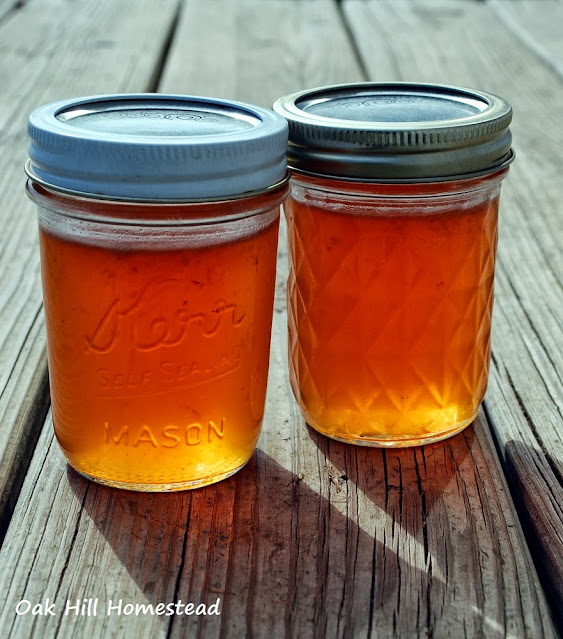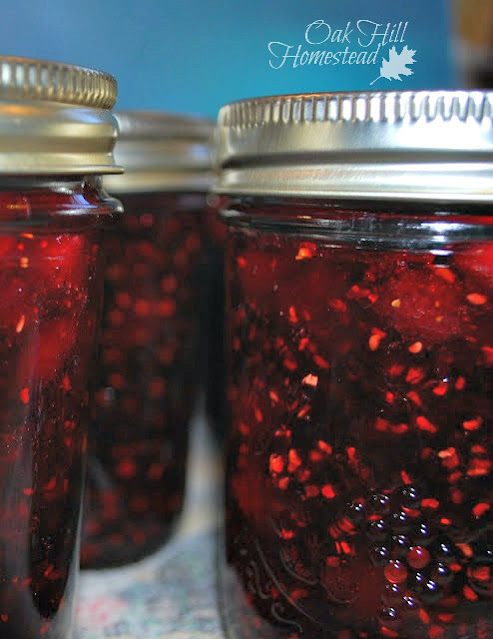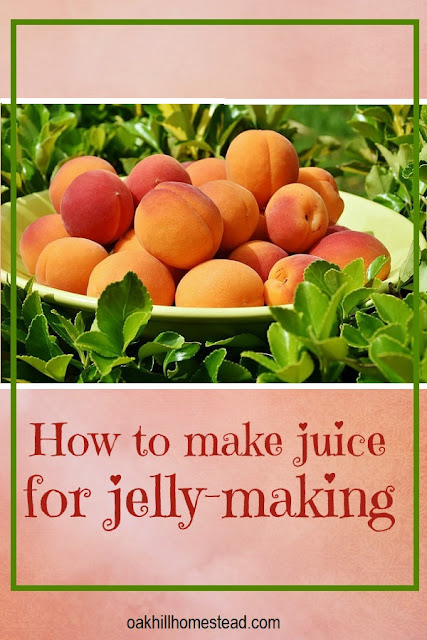You can preserve delicious summer fruits and berries by making fruit juice, which can be frozen, canned, used to make jelly, or added to smoothies.
Make fruit juice for jelly
Summer fruits and berries are in season, plentiful and at their least expensive.
Even better if you've grown them yourself. There is nothing better than sun-ripened berries from your own garden or fruit from your own trees. Homegrown tastes so very good.
This post contains affiliate links. You can read my disclosure here.
How can you save all that goodness for later? There are several ways to preserve those delicious summer fruits, including
- freezing sliced fruit or whole berries
- dehydrating
- canning
- turning them into jam or jelly
In this article we're going to learn how to make juice that will then be made into jelly.
What's the difference between jam and jelly?
Jam is made from fruit, pectin and sugar.
This mixture is boiled quickly until the fruit is soft and thick. It no longer resembles individual pieces of fruit, but you can still see soft lumps of the fruit and seeds (if the jam is made from berries).
Jam spreads easily but can be plopped from a spoon into a soft "blob."
Jelly is made from fruit juice, pectin and sugar. It often includes an acid such as lemon juice.
Jelly is also boiled quickly, but then its differences from jam are a bit more noticeable: jelly is clear, and is firm enough to hold its shape.
As well as fruit jellies, you can also make jelly from herbs, tea, wine, and flowers such as lilacs and rose petals.
Jam is actually easier to make since you can skip the step of making fruit juice, but I love them both. Jam or jelly, it makes no difference to me as long as they are tasty!
What to do with jelly and jam
You can do more with jelly and jam than just spread on toast or combine with peanut butter in pb&j sandwiches.
They're delicious when served with pancakes or french toast (especially jelly that didn't gel very well and resembles syrup more than jelly), in "dump chicken" made in the slow-cooker, in jam bars, cakes and cookies.
Jam and jelly also make delicious gifts for your favorite people: family, friends, your fellow office workers, teachers, and your mail carrier, just to name a few.
Yes, you can use commercial, bottled fruit juice to make jelly, but it's so easy to make juice from your favorite summer fruits. Let's do it!
This post contains affiliate links. For more information, read my disclosure.
How to make juice from fruits and berries
Start by sorting your fruit and discarding any that is damaged or spoiled.
Grapes and berries:
Wash gently to prevent loss of juice. Place fruit in a large, heavy saucepan and add enough water to keep the fruit from scorching.
Mash them in the pan to start the flow of juice - I use my mother's potato masher to crush them.
Bring the water and fruit to a boil, stirring to prevent scorching, then reduce the heat. Simmer for about ten minutes until soft.
Blackberries only need about five minutes of simmering.
Apples and other hard fruits:
Wash fruit and chop into small pieces. There's no need to peel the fruit; in fact, natural pectin is more concentrated in the apple peels and cores.
Place fruit in a large, heavy saucepan and add about one cup of water per pound of fruit.
If you're using apple peels and cores only instead of whole fruit, just add the peels and cores to your saucepan, add the water just as though you're using whole apples - about one cup of water per pound of apple scraps - and proceed with the directions.
Using high heat, bring the water and fruit to a boil, stirring to prevent scorching.
Then reduce the heat and simmer for about 20-25 minutes until soft. The time needed will depend on the firmness of the fruit you're using.
Apple peels and cores won't need as much time. I simmer until the juice is the color I want so I know there's plenty of flavor.
Don't overcook your fruit as this will affect the flavor, color and the natural pectin in the fruit, but the fruit should be very soft and some hard fruits might need to be simmered longer.
Additional water can be added to the saucepan if needed.
Click here to subscribe to The Acorn, Oak Hill Homestead's weekly-ish newsletter.
Strain the juice
Set up a jelly bag and stand over a large bowl and pour your fruit and juice into the damp bag. Let it drain naturally without pressing or squeezing for the clearest juice and ultimately, the prettiest jelly.
Discard the strained fruit and seeds on your compost pile or give it to your chickens. They'll thank you for it.
Your juice is now ready to make jelly!
How to freeze fresh fruit juice
But if you prefer, you can freeze the juice and make jelly later. I do this a lot, because my kitchen is really hot this time of year. Making jelly in the winter warms up the house and adds humidity to a dry house, too.
Measure the juice into the amounts you'll use in a jelly recipe and freeze it in well-labeled freezer bags or containers.
If your favorite jelly recipe calls for six cups, you can divide the amount into two quart-size freezer bags or use a gallon-size bag.
Lay the bags flat on your freezer shelf to freeze. Once frozen, you can stand them up like books or stack them on top of each other.
What to do with leftover fruit juice
If you have leftover juice after making jelly, you can put it to use in the following ways:
- freeze it
- add it to other kinds of fruit juice to make "mixed fruit jelly"
- use it in smoothies - blackberry juice in smoothies is my absolute favorite!
My favorite jelly and jam recipes
Speaking of my absolute favorites (because who can have just one favorite?) there are three kinds of jam and jelly I make every year.
I make Harvest Apple Jelly with the apples from our trees. We have several different varieties of apples and I use them all in this jelly. It tastes and smells amazing.
You can also make this jelly using apple peels and cores instead of whole apples. Just use the directions above to make apple juice from apple peels, then proceed to make jelly.
We also like Triple Berry Jam made from strawberries, raspberries and our wild blackberries. I love each kind of berry separately but together they are especially awesome.
If you don't like seeds in jam, you can make juice with the raspberries and blackberries, add it to strawberry pulp (not juice), and make jam.

This Spiced Caramel Pear Jam is absolutely delicious, and almost decadent! We don't have pear trees but I wish we did.
Sometimes I'm fortunate enough to barter some from a friend. When I can get them, I make this spiced caramel pear jam and hoard the little jars since pears are harder to come by.
While those are my Top Three, I'll happily top my morning English muffin with raspberry jam, blackberry jelly or peach jam too.
For more food preservation, gardening and simple, frugal living tips, subscribe to The Acorn, Oak Hill Homestead's weekly-ish newsletter, and join me on Facebook, Instagram and Pinterest. I'd love to see you there!
You might also enjoy these posts:
Your guide to preserving apples
How to ripen and can pears
Lessons from the blackberry patch
~~~~~
My mission is to inspire and encourage you to live a simple, joyful life,
no matter your circumstances or where you live. Join me here:
Facebook | Pinterest | Instagram | Subscribe




















